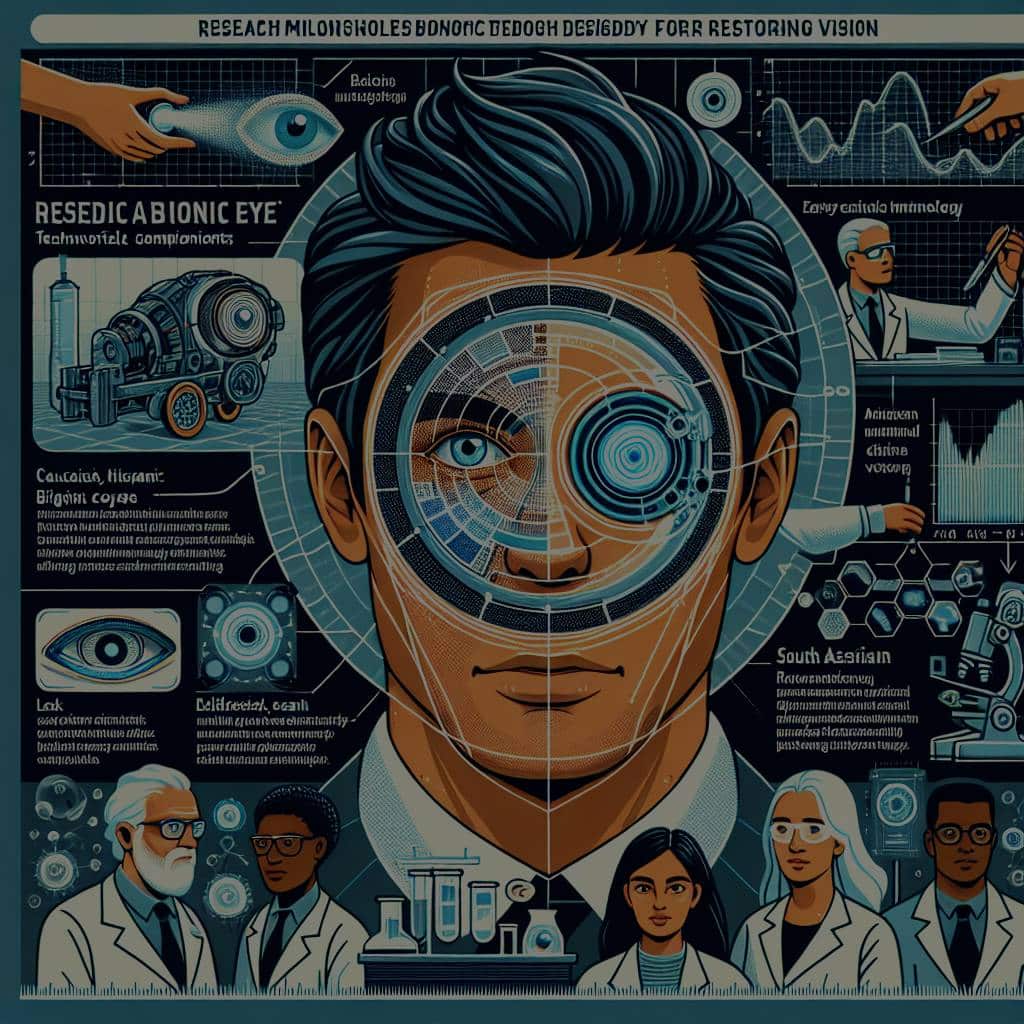The concept of bionic eyes has always been a fascinating blend of science fiction and reality. Yet, in recent years, this once seemingly impossible idea has started to become a reality. Medical researchers and technology experts have been working tirelessly to develop bionic eye implants that could restore the gift of sight to people who have lost it due to certain degenerative eye diseases. But what exactly is a bionic eye? How does it work, and what kind of progress has been made in this field? Let’s delve into the world of bionic eye research and its potential for restoring vision.
The Concept and Working of a Bionic Eye
A bionic eye, or retinal prosthesis, functions by converting light into electrical signals that mimic the natural function of photoreceptor cells in the retina. When these cells degrade due to diseases such as retinitis pigmentosa or age-related macular degeneration, vision is lost. But a bionic eye could potentially restore this lost vision by bypassing the damaged cells and transmitting the electrical signals directly to the brain.
Have you seen this : How Are Microgrids Contributing to Energy Independence in UK Communities?
The implantation process involves placing a microchip in the eye’s retina, connected to a small camera mounted on a pair of glasses. The camera captures visual information and sends it to the chip, which transforms it into electrical signals. These signals are then sent to the brain via the optic nerve, where they’re processed into visual images.
The complexity of mimicking the human eye’s intricate design is enormous. Yet, the advancements in bionic eye research have been remarkable. The Argus II, developed by Second Sight, is currently the only FDA-approved retinal prosthesis. This device has granted some degree of vision to patients who were previously completely blind, allowing them to perceive light and shapes.
Topic to read : Which kitchen accessories shop should you choose in Canada ?
The Latest Advancements in Bionic Eye Research
While the Argus II has made significant strides in bionic eye technology, it is not without its limitations. The vision it provides is still limited and doesn’t allow for color perception. But recent advancements promise a future where bionic eyes could offer much more detailed vision.
One of the most significant breakthroughs is the development of a new type of retinal implant by a group of scholars. It utilizes near-infrared light to stimulate retinal cells, a technique that could potentially provide a higher resolution image than the current devices. A recent study published in the journal PubMed illustrates the promising results of this new approach.
Meanwhile, the Australian-based company Bionic Vision Technologies is developing a device called the Bionic Eye. This implant uses a different mechanism to stimulate the retina’s cells. Instead of relying on a camera, the Bionic Eye uses a pair of glasses equipped with a video processing unit that communicates wirelessly with the implant. This could potentially offer patients a more natural experience of vision.
The Role of the Brain in Visual Processing
While the focus of bionic eye research has been primarily on the retinal implant itself, it’s crucial to remember that vision isn’t just about the eye – it’s also about the brain. The brain is responsible for interpreting the electrical signals sent by the retina, and any successful bionic eye needs to consider how the brain processes these signals.
The brain’s role in visual processing is complex and still not fully understood by science. However, researchers are discovering that the brain is remarkably adaptable. For example, studies on patients with the Argus II implant have found that over time, their brains learn to interpret the signals from the device better, leading to improved vision.
This adaptability, known as neuroplasticity, is a promising field of study for bionic eye research. It suggests that even if a bionic eye cannot perfectly mimic the function of a natural eye, the brain may still be able to adapt and interpret the signals it receives, providing the patient with a usable form of vision.
Challenges and Future Directions in Bionic Eye Research
Despite the promising advancements, the field of bionic eye research is not without its challenges. One of the most significant is biocompatibility – ensuring that the materials used in the implant won’t cause adverse reactions when placed in the human body. Furthermore, the delicate nature of retinal surgery makes the implantation process risky and complex.
Another critical challenge is cost. Currently, the Argus II retinal prosthesis system costs around $150,000, not including the cost of surgery and rehabilitation. This makes the technology inaccessible for many people who could potentially benefit from it.
However, as research continues and technology advances, the cost of these devices is expected to decrease. Moreover, the potential of bionic eyes to restore vision makes this an area of research worth pursuing. As we move forward, the focus will likely shift towards improving the resolution of the images produced by the implants and developing more sophisticated methods for stimulating the retina’s cells.
The world of bionic eye research is an exciting mix of biology, technology, and possibility. With every new discovery, we move one step closer to the time where vision loss is no longer an insurmountable barrier.
Improvements in the Field of Bionic Eye Research
Bionic eye research is primarily aimed at improving vision for those affected by degenerative eye diseases like retinitis pigmentosa and macular degeneration. A major focus of recent advancements has been on increasing the resolution of the images produced by bionic eyes. Since the introduction of Argus II by Second Sight, researchers have been striving to enhance the user’s ability to see more precise details and perceive colors.
A study published in Google Scholar and PubMed revealed that a group of researchers had successfully used electrical stimulation to promote the growth of new nerve cells in the visual cortex, a concept that could be beneficial for bionic eye applications. This electrical stimulation technique could potentially be used to activate more cells in the retina, leading to a higher resolution image.
Simultaneously, another recent breakthrough has been made by the Australian-based company Bionic Vision Technologies. Their device, known as the Bionic Eye, uses a video processing unit instead of a camera to interact wirelessly with the retinal implant. This innovative approach could potentially offer a more natural and immersive visual experience for the users.
Moreover, the rise of computer vision technology has also shown promise in this field. By integrating computer vision with retinal prosthesis, researchers hope to create smart bionic eyes that can analyze visual scenes, recognize objects, and even predict movement, delivering a much richer visual perception to the users.
Conclusion: The Future of Bionic Eye Research
Bionic eye research is a rapidly advancing field, offering hope to individuals suffering from vision loss due to degenerative eye diseases. Despite the challenges related to biocompatibility, surgical risks, and high costs, the remarkable progress made in recent years is a testament to the resilience and ingenuity of researchers worldwide.
The combination of neuroplasticity, advanced technology, and medical research suggests a future with improved visual prostheses capable of restoring a significantly higher degree of vision. As the costs of these devices decrease with technological advancements, the goal of making bionic eyes accessible to all who need them becomes more achievable.
As we continue to explore the potential of bionic eyes, we must remember the incredible human capacity for adaptation. As revealed by the success of the Argus II users, our brains are capable of learning and adapting to new forms of visual input. This inherent adaptability will undoubtedly play a crucial role in the successful implementation and future advancements of bionic eye technology.
On this journey, free article platforms like PubMed and Google Scholar have been and will continue to be invaluable resources for sharing new research findings and fostering global collaboration in this exciting field.
In conclusion, the world of bionic eye research is a fascinating testament to human resilience, adaptability, and technological prowess. With each new study, free article, and PMC free access, we move one step closer to a future where vision loss is no longer an insurmountable barrier, but a challenge that can be overcome through the power of human ingenuity and technology.






